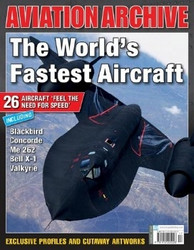|
Автор книги: Allan Burney (Editor)
Серия: Aviation Archive 33
Издательство: Key Publishing
Год выпуска: 2017
Формат: True PDF
Страниц: 100
Язык: английский
Размер: 20,2 Mb
Жажда скорости: Этот естественный инстинкт встроен в нашу психику, поэтому неудивительно, что с того момента, как братья Райт поднялись в воздух, это быстро превратилась в навязчивую идею. Освободившись от «земных» оков, теперь можно было достичь невероятных скоростей, а престиж стать самым быстрым человеком на планете быстро отразился в появлении нового вида спорта - воздушных гонках. Однако с началом Первой мировой войны игры стали смертельно серьезными. Скорость теперь приравнивается к выживанию. Искусство воздушного боя превратилось в искусство управления энергией, балет жизни и смерти. Технологии подстегивала война, и к началу 1920-х годов скорость самолетов превышала 200 миль в час. Во время Второй мировой войны эта скорость уже была увеличена вдвое, но возможности винтовых самолетов достигли своих пределов. С появлением реактивного двигателя все изменилось. Теперь единственным препятствием был звуковой барьер, и когда он был преодолен Чаком Йегером в 1947 году, история изменилась навсегда. 1950-е и начало 1960-х годов были золотым временем для «скорости», когда рекорды быстро переходили из рук в руки с одного берега Атлантики на другой. А затем появился самолет, который побил все рекорды и, что удивительно, остается непревзойденным по сей день, спустя 50 лет после того, как он разорвал небеса… бесспорный рекордсмен скорости среди всех, Lockheed SR-71 Blackbird. Это невероятная история покорения человеком воздуха, начиная от 6,82 миль в час на Wright Flyer до Mach 2+ Concorde. Рассматривая первые 60 лет эксплуатации самолетов, «Aviation Archive» выбрал 26 самых известных самолетов-рекордсменов, которые летали быстрее, чем что-либо прежде.
«Самые быстрые самолеты в мире» - это 33 выпуск серии «Aviation Archive». Он отличается беспрецедентным фотографическим охватом, включая множество эксклюзивных и редких снимков, которые никогда раньше не публиковались. Тексты и фотографии дополнены иллюстрациями «той эпохи», сделанными талантливыми художниками «Flight» и «Airplane», а также эксклюзивными профилями самолетов.
’The need for speed’. This natural instinct is embedded in all our psyche, so it is of little surprise that from the moment the Wright brothers staggered into the air, ying fast became an obsession. Freed of our ‘earthly’ bonds, previously unimagined speeds could now be attained and the kudos of being the fastest person on the planet quickly manifested itself into a new sport - air racing. However, with the advent of World War 1, the power games turned deadly serious. Speed now equated to survival. The art of dogfighting became the art of energy management, a ballet of life and death. War powered the technology, and by the early 1920s aircraft were exceeding 200mph. Come World War 2, this speed had already been doubled, but the limits of propeller-powered aircraft were now reaching their extremes. The arrival of the jet engine changed everything. Now the only barrier was the sound barrier and when this was smashed by Chuck Yeager in 1947, history was changed forever. The 1950s and early 1960s was a golden time for ‘speed’ with records rapidly changing hands from one side of the Atlantic to the other. And then along came the aircraft that would smash all records and, amazingly, remains unsurpassed to this day some 50 years after it tore the heavens apart… the undisputed speed-master of them all, the Lockheed SR-71 Blackbird. This then is the incredible story of man’s conquest of the air, ranging from the 6.82mph of the Wright Flyer to the Mach 2+ Concorde. Looking back over the first 60 years of powered ight, ‘Aviation Archive’ has picked out 26 of the most notable record-breaking aircraft that have gone faster than anything before.
‘The World’s Fastest Aircraft’ is No 33 in the successful ‘Aviation Archive’ series. It features unparalleled photographic coverage, including many exclusive and rare shots that have never been published before. The words and photographs are complemented by ‘period’ cutaways from the talented pens of the ‘Flight’ and ‘Aeroplane’ artists of the era, together with exclusive aircraft profiles from Pete West and Rolando Ugolini.
| 